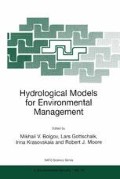Abstract
Studies of the variations of the level of natural water bodies are often based on the concept of a “stochastic reservoir”. The stochastic reservoir is a physically-based mathematical model of the water level variations in a closed reservoir. In this paper the stochastic reservoir is considered as a hydrological system governed by two input processes viz. river inflow and an effective evaporation from the water body (evaporation minus precipitation); a state variable viz. the water level variations; and an output process viz. the outflow from a water body. It is assumed that input processes are auto- and mutually correlated. The outflow is a function of the water level variations. This definition of a “stochastic reservoir” is very similar to the one suggested by Lloyd [15].
Access this chapter
Tax calculation will be finalised at checkout
Purchases are for personal use only
Preview
Unable to display preview. Download preview PDF.
References
Babaev, A.G. (1997) Ecological, Socialand Economic Problems of the Turkmen Caspian Zone, in M.H. Glantz and I.S. Zonn (eds.), Scientific, Environmental and Political Issues in Circum-CaspianRegion, Kluwer Academic Publishers, Dordrecht, pp.97–104.
Bagrov, N.A. (1961)On the variations in levels of closed lakes, Meteorologia i Gidrologia 6, 41–48 (in Russian).
Budyko, M.I. and Yudin, M.I. (1960) On variations in the levels of non-terminal lakes, Meteorologia i Gidrologia 8,15–19 (in Russian).
Frolov, A.V. (1985)Dynamic-Stochastical Models of the Long-Term Variations in the Non-Terminal LakeLevels, Nauka, Moscow (in Russian).
Frolov, A.V. (1989)Effects of autocorrelation in river inflow and effective evaporation on the regime of lake level variations, Meteorologia i Gidrologia, 4, 94–101 (in Russian).
Frolov, A.V. (1998)Influence of resumption of the marine water outflow into the Kara Bogaz Gol Bayon the long-term sea level fluctuations in the Caspian Sea, Meteorologia i hydrologia 7, 87–97 (in Russian).
Gates, D.G., and Diesendorf, M. (1977)On the fluctuations in levels of closed lakes, Journal of Hydrology 33, 267–285.
Golitsyn, G.S., Ratcovich, D.Ya., Fortus, M.I. and Frolov, A.V. (1998) On themodem rising of the Caspian Sea level, Wodnye resursy 25, 133–139 (in Russian).
Kaczmarek, Z. (1971) Some problems of stochastic storage with correlated inflow, IASH Publications 100,435–439.
Klemeš, V. (1974) Probability distribution of out flow in a linear reservoir, Journal of Hydrology 21,395–414.
Klemeš, V. (1978) Physically based stochastic hydrological analysis, Advances in Hydroscience 11, 285–356.
Kritsky, S.N. and Menkel, M.F (1946) Some positions of the statistical theory of the water bodies levels variations andits application to the study of the Caspian Sea, Proceedings of the First Conference on the River Flow Regulation, USSR Academy of Sciences, Moscow, 76–93 (in Russian).
Kritsky, S.N., Korenistov, D.V. and Ratcovich D.Ya. (1975) The variations in the Caspian Sea level, Nauka, Moscow.
Lloyd, E.H. (1963) Reservoirs with serially correlated inflows, Technometrics 5, 85–93.
Lloyd, E.H. (1993) The stochastic reservoir: exact and approximate evaluations of storage distribution, Journal of Hydrology 151, 65–107.
Muzylev, S.V. (1980) Theoretical-probabilistic analysis of the variations in the terminal lakes levels, Wodnye Resursy 5, 21–40(in Russian).
Muzylev, S.V., Privalsky, V.E. and Ratcovich, D.Ya. (1982) Stochastic Models in Engineering Hydrology, Nauka, Moscow (in Russian).
Phatarfod, R.M.(1979) The bottomless dam, Journal of Hydrology 40, 337–363.
Privalsky, V.E. (1988) Modeling long term lake variations by physically based stochastic dynamic models, Stochastic Hydrology and Hydraulics, 2, 303–315.
Ratcovich, D. Ya.(1993) Hydrological Principles of Water Supply, Water Problems Institute of the Russian Academy of Sciences, Moscow (in Russian).
Author information
Authors and Affiliations
Editor information
Editors and Affiliations
Rights and permissions
Copyright information
© 2002 Springer Science+Business Media Dordrecht
About this chapter
Cite this chapter
Frolov, A.V. (2002). The Caspian Sea as a Stochastic Reservoir. In: Bolgov, M.V., Gottschalk, L., Krasovskaia, I., Moore, R.J. (eds) Hydrological Models for Environmental Management. NATO Science Series, vol 79. Springer, Dordrecht. https://doi.org/10.1007/978-94-010-0470-1_8
Download citation
DOI: https://doi.org/10.1007/978-94-010-0470-1_8
Publisher Name: Springer, Dordrecht
Print ISBN: 978-1-4020-0911-2
Online ISBN: 978-94-010-0470-1
eBook Packages: Springer Book Archive

